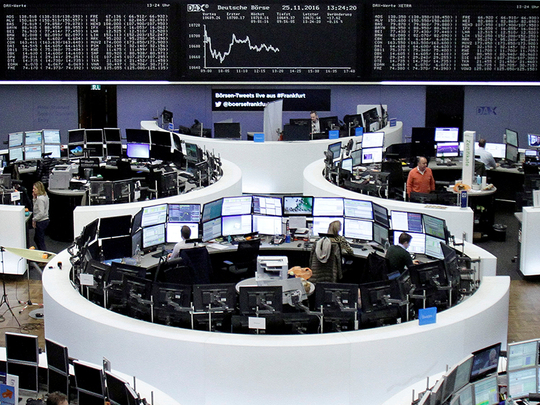
LONDON: The dollar’s best run in almost two years paused on Friday while Italian stocks continued to underperform peers in Europe as the countdown to a referendum on constitutional reform in the country entered its final week.
Futures on Wall Street were up 0.2 per cent in light trading. Bond and stock markets in the United States, which were closed overnight for Thanksgiving, will close early on Friday.
Italian stocks, the worst performers this year across major markets globally, were slightly lower, taking their year-to-date losses to more than 23 per cent. Concerns around non-performing loans have halved the value of Italy’s banks
this year.
A December 4 referendum on constitutional reform in Italy will kick-start a tense 18-month long political calendar in Europe with French, German and Dutch general elections due next year.
European equities were little changed by midday on Friday with defensive sectors such as health care and utilities clawing back some of their recent losses, while banks and commodity-related stocks were weaker. The pan-European STOXX 600 index remained on track for a third straight week of gains.
Despite growing concerns on Italy, European shares have gained 4.5 per cent since Donald Trump’s surprise victory in this month’s US presidential election.
“It looks as if the market is taking a breather after a good run. The market view is that Trump is going to spend more and will shield the US more so that we get higher inflation and higher domestic growth,” said Ronny Claeys, senior strategist at KBC Asset Management.
“The market has reacted positively on Trump, but this could change as his policies are vague at this stage. Investors will react more on his policy details.” European energy stocks fell 0.5 per cent after crude oil prices slipped around 1 per cent on rising Saudi supplies to Asian clients and a fall in Chinese imports.
A Saudi-led plan to agree on crude output cuts from the Organisation of the Petroleum Exporting Countries (Opec) and other producers next week would only impact supplies from February 2017 as most exporters sell their supplies two months ahead.
On the currency front, the euro rose 0.4 per cent to $1.0589
after weakening as far as $1.0518 on Thursday, its lowest point since March 2015.
Expectations of rises in US inflation and interest rates have driven the greenback to a gain of more than 6 per cent in October and November combined, its strongest showing over a similar period since its rally in early 2015.
Most investors expect those gains to continue, but a combination of the Thanksgiving break in the United States, market participants’ need to process corporate flows at the end of the month, and a raft of risks in the first half of December all speak for cashing in some of those gains now.
“US yields gapped higher at the open but we have been unable to hold those gains and that has encouraged some profit-taking,” said Jeremy Stretch, head of currency strategy at CIBC in London.
“There is a degree of consolidation (but) there is still a consistent bias that means the dollar will remain pretty much supported into the Fed meeting next month. The message seems to be to take some profit and we will be looking to go again.” In the European bond market, short-dated German government bond yields set a new record low and were on track for their biggest two-week fall in more than three years, highlighting demand for top-rated assets.
Demand for German debt for use as collateral for short-term lending in repo markets has helped drive two-year bond yields lower this week. Jitters ahead of an Italian referendum on Dec. 4 has also bolstered demand for German bonds, regarded as among the safest assets in the world.
—Reuters












